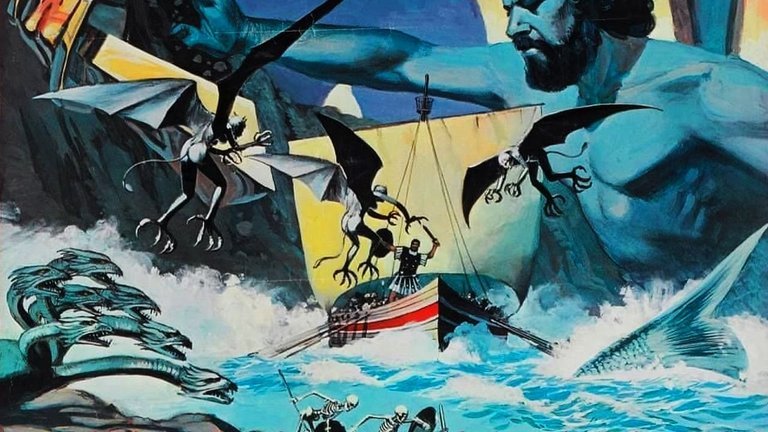Film Review: Jason and the Argonauts (1963)

The 1963 film Jason and the Argonauts, directed by Don Chaffey, stands as a remarkable testament to the artistry of special effects in cinema. In an era where such effects have become commonplace, there are still films that are primarily celebrated for their groundbreaking visual achievements. However, these films often attain their esteemed status not solely through their visual spectacle but through a combination of compelling storytelling, character development, and thematic depth. Jason and the Argonauts is one such film that, while renowned for its innovative effects, also possesses sufficient qualities that allow it to be appreciated as a significant piece of cinematic art.
Jason and the Argonauts is based on ancient Greek myths, specifically drawing from the Argonautica, a 2nd Century BC epic poem written by Hellenistic poet and scholar Apollonius of Rhodes. The plot begins with Pelias (played by Douglas Wilmer) seizing the throne of Thessaly through treachery, resulting in the death of King Aristo and the threat to his offspring. Jason (played by Todd Armstrong), the prophesied avenger of his father’s death, escapes as an infant and returns as a young man to reclaim his rightful place. To solidify his claim, he embarks on a perilous journey to acquire the fabled Golden Fleece, an endeavour that Pelias manipulates to rid himself of Jason by sending him far from home. Jason enlists the help of Argus (played by Laurence Naismith) to construct the ship Argo and gathers a crew composed of Greece's greatest heroes, including Hercules (played by Nigel Green). Their voyage leads them to Colchis, where they confront King Aeëtes (played by Jack Gwillim) and ultimately find unexpected assistance from Medea (played by Nancy Kovack), the king’s daughter who falls in love with Jason.
While Jason and the Argonauts is credited to director Don Chaffey and producer Charles S. Schneer, it is Ray Harryhausen’s name that has become synonymous with the film. Harryhausen was a pioneering master of special effects, particularly known for his stop-motion animation techniques that brought mythical creatures to life. The film features iconic beings such as harpies, a bronze giant, a hydra, and the unforgettable skeleton army that Jason battles in one of cinema's most celebrated sequences. Harryhausen regarded this film as his crowning achievement among his extensive body of work. Despite the limitations compared to modern CGI technology, the special effects remain impressive for their time and continue to hold a nostalgic charm that resonates with audiences today.
Despite its visual splendour, Jason and the Argonauts suffers from narrative weaknesses that detract from its overall impact. The screenplay by Beverley Cross and Jan Read effectively condenses and simplifies complex source material; however, it leaves several plot threads unresolved. The climax involving Jason’s confrontation with Pelias is notably absent from the film's conclusion, which can leave viewers feeling unsatisfied. Furthermore, the lack of well-defined antagonists diminishes tension; Pelias's role is significantly reduced after his initial appearance, leaving a void in terms of villainy that could have enhanced dramatic stakes.
The casting choices also present challenges for the film’s reception. Todd Armstrong embodies the physicality expected of an ancient Greek hero but lacks the charisma necessary to engage audiences fully. His chemistry with Nancy Kovack is minimal; she was chosen more for her exotic appearance than her acting prowess. In contrast, the British supporting cast shines brightly; Nigel Green’s portrayal of Hercules stands out as particularly robust and engaging.
An ingenious narrative device employed in Jason and the Argonauts is the inclusion of a Greek chorus represented by gods on Mount Olympus who observe, comment and occasionally intervene in human affairs. Led by Zeus (played by Nial McGinnis) and Hera (played by Honor Blackman, actress who would a year later become famous as Pussy Galore in James Bond film Goldfinger), these divine figures add a layer of commentary on fate and intervention in human lives, enhancing thematic depth while providing moments of levity throughout Jason's arduous journey.
Another element that elevates Jason and the Argonauts is Bernard Herrmann's powerful musical score. Herrmann’s compositions have significantly contributed to other films featuring Harryhausen's effects, including The 7th Voyage of Sinbad. His score not only underscores dramatic moments but also enriches scenes such as Medea’s dance towards the film's conclusion, showcasing how music can enhance visual storytelling.
Ultimately, Jason and the Argonauts manages to be an entertaining cinematic experience despite its flaws. Its brisk pacing and relatively short runtime make it accessible even to those who may not be particularly interested in classic special effects or mythological narratives. The film remains engaging through its adventurous spirit and nostalgic charm.
RATING: 7/10 (+++)
Blog in Croatian https://draxblog.com
Blog in English https://draxreview.wordpress.com/
InLeo blog https://inleo.io/@drax.leo
Hiveonboard: https://hiveonboard.com?ref=drax
InLeo: https://inleo.io/signup?referral=drax.leo
Rising Star game: https://www.risingstargame.com?referrer=drax
1Inch: https://1inch.exchange/#/r/0x83823d8CCB74F828148258BB4457642124b1328e
BTC donations: 1EWxiMiP6iiG9rger3NuUSd6HByaxQWafG
ETH donations: 0xB305F144323b99e6f8b1d66f5D7DE78B498C32A7
BCH donations: qpvxw0jax79lhmvlgcldkzpqanf03r9cjv8y6gtmk9
Posted Using InLeo Alpha
Congratulations @drax! You have completed the following achievement on the Hive blockchain And have been rewarded with New badge(s)
You can view your badges on your board and compare yourself to others in the Ranking
If you no longer want to receive notifications, reply to this comment with the word
STOPCheck out our last posts: